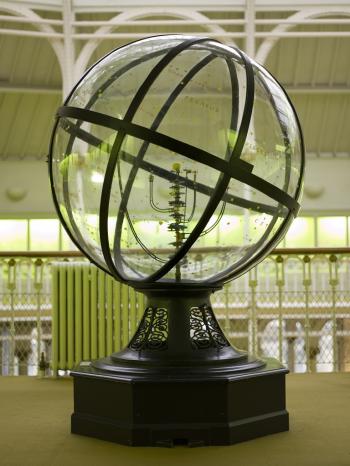An Orrery is a mechanical simulation model of the motion of the planets in our solar system. An Orrery demonstrates how the planets move in orbit around the sun in  relative motion to the other planets. So in a properly designed Orrery if the Earth model goes around the sun 30 times then Saturn will have circle the Sun just once. More advanced Orreries will even have the various planets rotate with an appropriate period, and very advanced models may have moons which in turn orbit the planets with the proper period.
relative motion to the other planets. So in a properly designed Orrery if the Earth model goes around the sun 30 times then Saturn will have circle the Sun just once. More advanced Orreries will even have the various planets rotate with an appropriate period, and very advanced models may have moons which in turn orbit the planets with the proper period.
Orreries were the ultimate in mechanical devices in Astronomy. Universities would spend fortunes to build them in varying sizes and features. They could be as small as a desktop model, to as large as a closet. Today there are some Orreries in museums that take up entire rooms! Many older models are still around, albeit not operational and they show how our knowledge of the Solar System has changed – older models may not have all or even most of Jupiter’s moons, Mar’s two moons are often depicted as perfect spheres, and so on. The most amusing are the older models built before the discovery of Pluto – they were naturally built without that dwarf planet, and this absence was noted for many decades – until Pluto was demoted from planetary status and the old Orreries became accurate once more!
Orreries are almost never perfectly to scale – they are meant to show orbital periods, not accurate distances from the sun. The planets are often oversized as well, but that is necessary for the visual presentation.
These days, few large Orreries are built outside of museum entrance halls. Computer simulations on screens cover most of the mathematical needs, but very often students of Astronomy may need a decent physical demonstration of plnaetary rotation. Fortunately, there are some Orreries still being manufactured! Not just Orreries, but several kinds of solar system simulations!
First up we have a classic powered Orrery. This is a simple model showing just the Major planets – no moons, no dwarf planets, but it does use a classic gear driven system to work out the proper planetary periods! The model moves quietly and includes a Teacher’s guide with 10 lesson plans! This model is perfect for classroom or home schooling for ages 8-14 (grades 3-9).

For a more economical model, we also have the Solar System Simulator. This model does not operate on gears, instead the planets are adjusted using the dates printed on the base. The planets are moved to show their position around the sun.

No Astronomy class plan would be complete without demonstrations to show how the Earth and Moon move around the Sun. For that we have the Earth-Moon Orbiter Simulator

This simulator is manually gear driven and can be used to show the various aspects of the Moon revolving around the Earth and the Earth in turn revolving around the sun! Daylight, night, seasons and phases of the moon are all demonstrated with this model. But perhaps you want to show a bit more? For that we also have an Illuminated Earth-Moon Orbiter Simulator

With this simulator you cover the same topics as the non-illuminated model, but with a much more effective visual aid as with an actual illuminating ‘sun’ give the effect of what light from the sun actualy does!
These models are excellent for the classroom or for pooled equipment among home-schoolers.
www.spectrum-scientifics.com












